|
Open Space
The Great Lessons of
|
Many people might think that ancient civilizations were very primitive. However, from architectural sites such as the pyramids in Egypt, the ruins in Central and South America or Stonehenge in Great Britain, we see that they could not have been easily constructed, even with the engineering knowledge and technology of today. Have you ever wondered how the huge blocks for these structures could have possibly been cut, transported and placed together so precisely? It has been speculated that the stones were cut with electro-ultrasound and transported above the ground by anti-gravitational techniques.
Master once said, “We have seen, we have read and we have proof of many civilizations, which have been buried under the ground due to the tendency of following negative path. History has proven all this. And now we even have many discoveries of these ancient cities, which were somehow much more glorious than our civilization. They have gone; they progressed up to the very top level of civilization, also to the very top level of electronic and mechanic development. But even then they didn’t pursue God; they didn’t pursue the right principle of life, so they also went down. These discoveries should be the great lessons, for our generations and many other generations to come.” (Spoken by Supreme Master Ching Hai, Hsihu, Formosa, May 8, 1992, News #27)
Master has also revealed some insights about how these ancient civilizations came to exist: “A long time ago, there were people from the higher worlds who came to Earth to teach us. Some of them were from the middle levels, some from higher levels and some from the highest level. The beings from the middle levels taught us how to make some advanced machinery and taught us how to develop some of our wondrous supernatural powers, which enabled us to live a more comfortable, rich and civilized life. The glorious eras we had on Earth such as at the time of Atlantis, were the result of teachers who came from the middle level worlds. In those days, our world was very civilized, and present-day archaeologists sometimes find evidence of the civilizations of those times.” (Spoken by Supreme Master Ching Hai, Tokyo, Japan, March 11, 1992, Originally in Chinese)
The following are a few examples of the discoveries that have been made about these previously glorious civilizations, and a reminder of the lessons we can learn from their silent remains.
The Great Pyramid of Giza
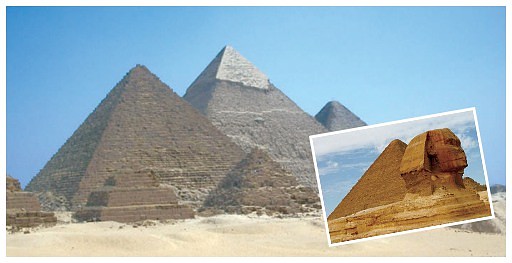
Standing in Egypt, this impressive structure is the oldest and last remaining of the Seven Wonders of the World. The pyramid was constructed of blocks of limestone, basalt or granite, which were cut and trimmed before being fit into place. These blocks weighed from two to 15 tonnes (16.5 tons) on average. An estimated 2.4 million blocks were used in the construction.
The accuracy of the pyramid’s workmanship is such that the four 750-foot long sides of its base have a mean error of only 58 mm (approximately two inches) in length, and deviate only one minute in angle from a perfect square. The sides of the base’s square are closely aligned to the four ordinal compass points (to within 3 minutes of arc), and this orientation is based not on magnetic north, but true north.
At the time of its construction, the Great Pyramid was surfaced by white casing stones – slant-faced, but flat-topped blocks of highly polished white limestone. The casing stones of the Great Pyramid were cut to such optical precision as to be off true plane over their entire surface area by only 1/50th of an inch. They were fitted together so perfectly that the tip of a knife cannot be inserted between the joints even to this day.
On the north-facing side is the pyramid’s entrance. A number of corridors, galleries, and escape shafts lead to the King’s chamber, or were intended to serve other functions. The King’s chamber is located at the heart of the pyramid, only accessible through the Great Gallery and an ascending corridor. Most impressive is the sharp-edged stone over the doorway of the King’s Chamber, which is over 3 m (10 ft) long, 2.4 m (8 feet) high and 1.3 m (4 ft) thick. All of the interior stones fit so well that a card won’t fit between them.
The Inca Empire
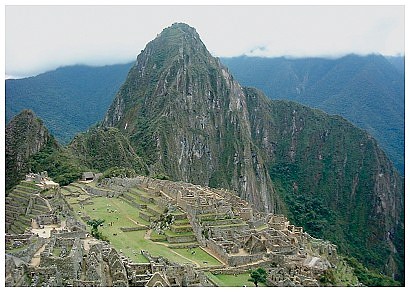
A view of Machu Picchu, the “Lost City” of the Incas
This civilization, which appeared in the region of South America now known as Peru, was the largest empire in Pre-Columbian America and the largest in the world at the time of its collapse. The Incas are perhaps best known for their engineering works and architecture. They constructed an extensive system of well-built and constantly maintained roads, covering at least 23,000 km (over 14,000 miles). This road network facilitated communication and the movement of people and goods. To cross the many steep ravines found in the Andes Mountains, the Incas built impressive suspension bridges. On the mountainsides in many regions, they built elaborate terraces to increase food production.
Teotihuacan
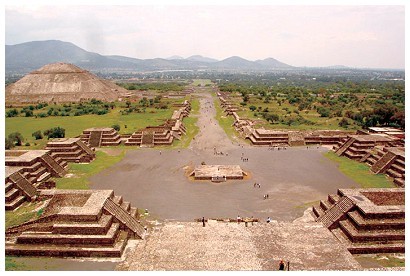
Pyramid of the Sun in Teotihuacan, Mexico
The ancient city of Teotihuacan, located near Mexico City in the Mexican Highland, is impressive both in the size of the Pyramids of the Sun (third largest in the world) and its “sister” structure, Pyramid of the Moon, as well as the peaceful quality of the people who originally inhabited it. Teotihuacan is unique in the fact that the paintings, or murals, that have been uncovered there do not depict the thematic violence found in other ceremonial sites; they portray a society that seemed to be interested more in astronomy and the symbols of spirituality from that time.
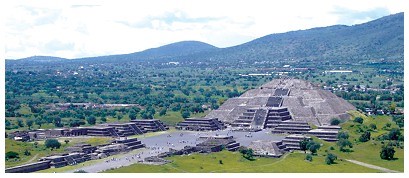
Pyramid of the Moon
The city seems to have functioned for centuries as a well-developed center. However, it never regained its former stature after a rather sudden collapse. No one knows who built Teotihuacan. The names used today are all from Aztecs who found the site long after it was abandoned. Aztecs imagined the place had been built by giants.
Easter Island
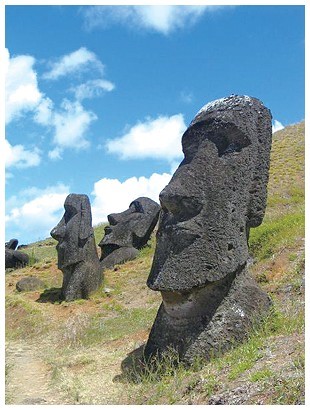
Some of the large stone statues, or moai, on Easter Island
In the south Pacific Ocean, 3,600 km (2,237 miles) from the continent of South America lies Easter Island. On this small “dot” in the middle of the ocean, 887 large stone statues, or moai, were carved from rough, hardened volcanic ash and placed around the island. The largest moai is over 70 feet tall and weighs over 150 tons (300,000 pounds). The quarry there seems to have been abandoned abruptly, with half-carved statues left in the rock. Unfortunately, there is no formal written record to help tell the story of this remote land, but the sight of these giant statues even today inspires a sense of their original spiritual significance.
Stonehenge
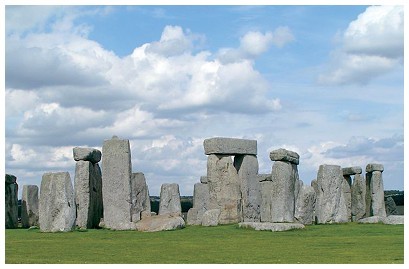
Stonehenge in Southern England
Stonehenge stands on the open green downland of the Salisbury Plain, two miles west of the town of Amesbury, Wiltshire, in Southern England. It is an arrangement of concentric rings and horseshoe shapes comprised of very large ancient stones. The magnetism of Stonehenge is unmistakable and can’t be explained by architecture alone. With each stone weighing up to 45.4 tonnes (50 tons), it is regarded as a great and impressive feat of engineering in its day.
The outside set of stone pillars, complete with linking top stones, called lintels, form a complete circle. How the builders would have known how to shape the lintels in such a way that they would remain flat but still form a gentle circle was considered architecturally advanced for the time period. Although it is not clear who built Stonehenge, nor for what purpose, it has been speculated that it was either a temple dedicated for worship, an astronomical observatory, a sacred burial site, the work of extraterrestrial beings, an extraterrestrial landing site, a Stone Age calculator or clock or a giant astronomical observatory, etc.
Compared to some of the accomplishments of these ancient civilizations, the advancements of today’s science and technology seem much less remarkable. Yet, earthlings are still capable of destruction through the manmade and natural disasters that could be caused by nuclear wars, misuse of technology, pollution, etc., if we keep on building up negative atmosphere around our planet, going against the nature, interfering with ecological systems and creating barriers among people.
A tremendous percentage of the people on Earth have already experienced the benefit of spiritual elevation. As we continue to enter the Golden Age, we have a chance to fulfill the kind of future Master was describing when She said, “If every person in this world can practice spiritually, our Earth will become a very civilized and high level planet, like the other planets. At that time, we will be able to invent anything, and fulfill any of our material needs, because we are elevated spiritually, our wisdom is raised, and we can do anything… In those worlds, the percentage of wisdom used is much higher than in our world. That is the only difference between them and us. Most intelligent person on earth uses only four percent of their intelligence. Can you imagine? Only four percent! That is why the earth is relatively backward.” (Spoken by Supreme Master Ching Hai, Tokyo, Japan March 11, 1992, Originally in Chinese)
Many people have foreseen that our Earth
will advance very quickly in this century, and many wonderful changes
will happen within a few years. In fact, many incredible technologies
are ready to be transferred to earthlings, if only we have the keys of
love and wisdom!![]()
| << | Contents | >> |
|
Refer this page to friends
|
||